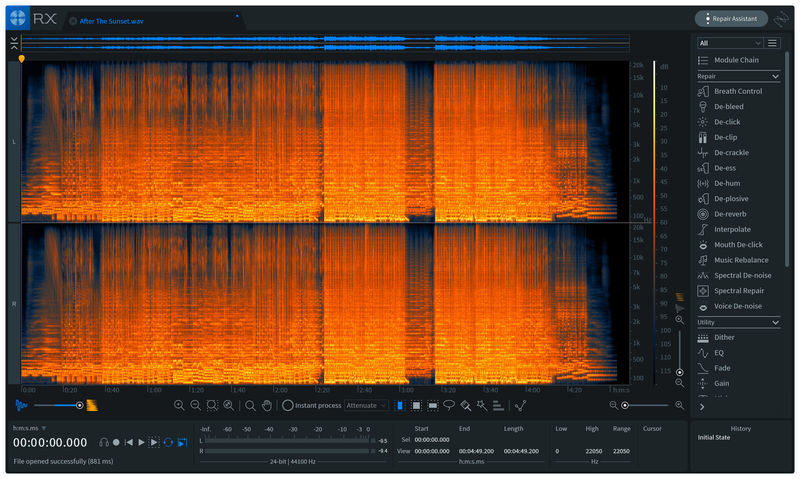Izotope Rx Leveler Response
Overview
Deconstruct analyzes your audio selection and separates the signal into Tonal, Noisy, and Transient (optionally) audio components. The separate components of the signal can then be cut or boosted individually using their associated Gain control.
RX 7 Standard is the audio repair toolkit used on albums, movies, and TV shows to restore damaged, noisy audio to pristine condition. View More Add to Cart.
Controls
- TONAL GAIN [dB]: Adjusts the level of the signal’s tonal components. Boosting a tonal signal (voice or instrumental) can help lift it out of a noise floor.
- NOISY GAIN [dB]: Adjusts the level of noisy components of the signal. This can be very useful for highlighting areas of raspiness or distortion only, and then attenuating the noisy gain to reduce overall distortion.
- SEPARATE TRANSIENTS: Enables transient separation processing and activates the Transient Gain control.
- TRANSIENT GAIN [dB]: Adjusts the level of transient components of the signal. This can work as a transient shaper or a declicker, allowing you to attenuate or boost clicks and attacks.
Transient Separation Performance Note
Run the ‘Trilian Library Update.exe’. Run the ‘Bob Moog Tribute Patch Libary Update.exe’. Run the ‘Omnisphere 2 Data Updater.exe’. /how-to-install-omnisphere-2-fl-studio-12-windows.html. Run the Keygen (Spectrasonics2048KeyGen.exe), Click on ‘Patch’ and goto here “C:Program FilesSteinbergvstplugins” and select the ‘Omnisphere.dll’ file.
- The Separate Transients option allows you to control the level of transients, but incurs additional CPU load.
- Increased CPU load may impact the performance of Preview, in this case, using the Compare functionality instead of Preview is a recommended alternative.
- The Separate Transients option allows you to control the level of transients, but incurs additional CPU load.
- TONAL/NOISY BALANCE: Modifies the default weighting of the separation algorithm used by Deconstruct to categorize components of a signal as either “noisy” or “tonal.”
- Negative values (Tonal weighting) will classify more of the “noisy” components of a signal as “tonal” components and apply Tonal Gain to them during processing.
- Positive values (Noisy weighting) will classify more of the “tonal” components of a signal as “noisy” components and apply Noisy Gain to them during processing.
- Negative values (Tonal weighting) will classify more of the “noisy” components of a signal as “tonal” components and apply Tonal Gain to them during processing.
- ARTIFACT SMOOTHING: Reduces “musical noise” artifacts that are often characteristic of FFT-based processing. Increase this slider if Deconstruct’s output sounds watery, but decrease it when too much smoothing reduces the separation between signal components.
What is an FFT?
- Fast Fourier Transform: a procedure for the calculation of a signal frequency spectrum. The greater the FFT size, the greater the frequency resolution, i.e., notes and tonal events will be clearer at larger sizes. However, when using FFT-based processing, the more audio you remove from your source, the more likely you are to create undesirable artifacts.
- Fast Fourier Transform: a procedure for the calculation of a signal frequency spectrum. The greater the FFT size, the greater the frequency resolution, i.e., notes and tonal events will be clearer at larger sizes. However, when using FFT-based processing, the more audio you remove from your source, the more likely you are to create undesirable artifacts.
More Information

Izotope Rx Leveler Response Review
- Deconstruct can be useful for a variety of audio files and applications, particularly when attempting to remove noise that varies throughout the length of a file.
- Deconstruct differs from the Spectral De-noise and Voice De-noise modules, which separate signal from noise based purely on amplitude. Deconstruct analyzes the harmonic structure of a signal independently of level. It does not matter if a tonal signal like hum is quiet or prominent. Deconstruct will treat it as a tonal component and adjust its gain accordingly.
- Deconstruct can be effective in removing residual vinyl noise that may be present after applying De-click or De-crackle processing. Using Deconstruct in this situation may produce better results than using the Spectral De-noise or Voice De-noise modules.